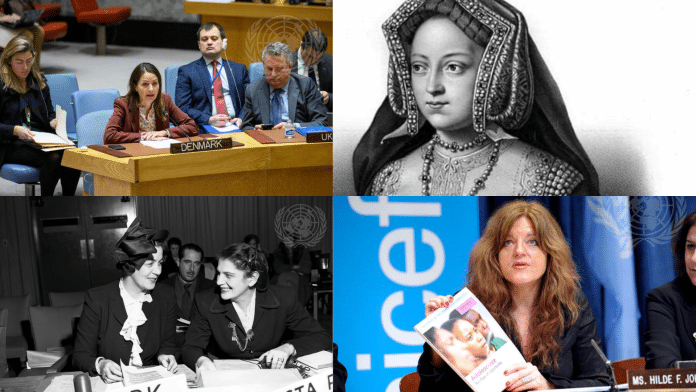The International Day for Women in Diplomacy. When the appointment of Finland’s first female ambassador Tyyne Leivo-Larsson was imminent in 1958 the country´s Prime Minister K.-A. Fagerholm tried to prevent it on the grounds of her sobriety.
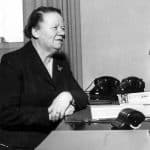
Historically, diplomacy has been the preserve of men. On 24 June, the International Day for Women in Diplomacy, it is time to recognize and celebrate the ways in which women are breaking barriers and making a difference in the field of diplomacy.
Nobel Prize winner
The first women to be appointed ambassadors in the Nordic countries made their marks on international relations.

Alva Myrdal was Sweden´s first female amassador (to India, 1955). In addition she also served as a senior official at the United Nations and UNESCO. However, it was for her work on nuclear disarmament that she shared the 1982 Nobel Peace Prize 1982 with Mexican diplomat, Alfonso García Robles.
Bodil Begtrup became Denmark´s female ambassador in 1955 they same year as Myrdal (to Iceland). A campaigner for women´s rights, Begtrup was vice chairman of the committee that negotiated the landmark 1948 Universal Declaration of Human Rights.
Twenty years later in 1975 it was Norway´s turn to appoint a woman, Kirsten Ohm, to an ambassadorship (Council of Europe). Iceland, however, waited until 1991 to appoint a female ambassador, Sigríður Á. Snævarr. As reported above Tyyne Leivo-Larsson was appointed the first Finnish female ambassador (to Norway) in 1958.
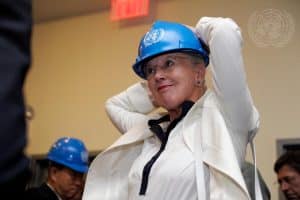
In the wake of Catherine of Aragon
The Spanish princess and later English Queen, Catharine of Aragon was the first woman to be appointed ambassador in 1507. Needless to say, diplomacy is of course conducted by heads of state and ministers, as well as professional diplomats.
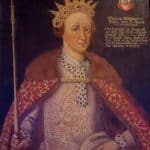
Almost 600 years later Queen Margrethe II of Denmark was an internationally well-known representative of her country during her reign (1972-2024).
Norway is still waiting for the first female monarch, since the Kalmar Union. Sweden had a female monarch briefly when Ulrika Elenora acceeded to the Swedish throne in the early 17th century.

Elected Presidents
The two Nordic Republics have both elected women to their presidencies.Iceland was the first country to elect a female President, Vigdís Finnbogadóttir (1980-1996) by universal suffrage, and has just elected a second woman, Halla Tómasdóttir.
In Finland Tarje Halonen, who had already served as the country´s first female Foreign Minister was elected President, the first and to date only woman to hold the position (2000-2016). For 68 days in 2003 both the Finnish President and Prime Minister were women during the short Prime Ministership of Anneli Jäätteenmäki, the first woman to serve in that post.
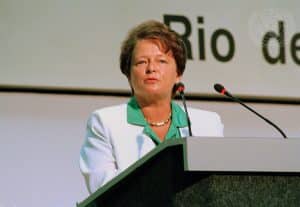
Gro Harlem Brundtland, Prime Minister of Norway
Brundtland broke the glass ceiling
With the exception of Finland, the Prime Minister has more responsibility for foreign relations than the more symbolic head of state in the Nordic countries. Many of the women who have served as Prime Ministers in the five Nordic countries have indeed been very prominent on the world stage.
Currently, Mette Fredriksen of Denmark is – unusually – the only female Prime Minister in the Nordic countries. She is Denmark´s second female Prime Minister after Helle Thorning-Schmidt (2011-2015). Until quite recently, two other Nordic countries had women Prime Ministers with high international visibility; Sanna Marin of Finland (2019-2023),and Katrín Jakobsdóttir of Iceland (2017-2024).
Gro Harlem Brundtland was the first woman in Norway and in the Nordic Countries to be appointed Prime Minister in 1981. She took on a prominent role on the international scene and left her mark on the UN with the report of the commission she chaired on Sustainable development. The only other Norwegian female Prime Minister in history, Erna Solberg, (2013-2021) has also undertaken many diplomatic assignments, including at the UN.
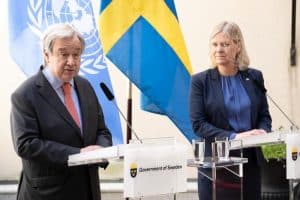
Sweden has only once had a woman as Prime Minister, Magdalena Andersson (2021-2022) but her first appointment lasted for only 7 seven hours due to a budget crises, which was soon resolved.
Eight Swedish female foreign ministers
On the other hand women have in the past few years dominated the office of Swedish Foreign Minister. Since Karin Söder (1976-1978) was appointed Foreign Minister in 1976 eight women in total have been Sweden´s top diplomat.

Only one woman has been Denmark´s Foreign Minister, Lene Espersen (2010-2011). This contrasts with Iceland, whose incumbent Foreign Minister, Þórdís Kolbrún Gylfadóttir, is the country´s fourth female top diplomat.
Her Finnish colleague is also female, but Elina Valtonen is only the second woman in that position since Tarja Halonen (1995-2000) was appointed 29 years ago, prior to her election to the Presidency.
The first Norwegian woman to be appointed Foreign Minister, Ine Marie Søreide (2017-2021) was actually succeeded by a another woman, Anniken Huitfeldt (2021-2023).
International diplomats
Much of world diplomacy takes place at international organisations and several Nordic women play or have played important roles. Some examples:
Hilde Frafjord Johnson (Norway) served as deputy executive director of UNICEF (2017-2011) and played a pivotal role in the peace process in Sudan.
Gro Harlem Brundtland (Norway) was the Director-General of WHO 1998 to 2003.
Grete Faremo (Norway) was Under-Secretary-General and Executive Director of UNPOS, the United Nations Office for Project Services (2014-2022)

Kirsi Madi (Finland) was appointed UN Assistant Secretary-General and UN Women Deputy Executive Director in 2023.
Helvi Sipilä (Finland) was appointed as the first-ever female Assistant-Secretary-General of the United Nations in 1972.
Elisabeth Rehn (Finland) was UN Undersecretary General 1998-199 and Special rapporteur for Human Rights in Bosnia and Herzegovina.

Ulrika Modéer (Sweden) is the External Relations Director of the United Nations Development Programme (UNDP) as well as UN Assistant Secretary-General since 2018.
Kirstine Damkjær (Denmark) was appointed Deputy Executive Director of UNOPS in 2024.
Ingibjörg Sólrún Gísladóttir (Iceland) was the Director of the OSCE Office for Democratic Institutions and Human Rights (ODIHR, 2017-2020)

